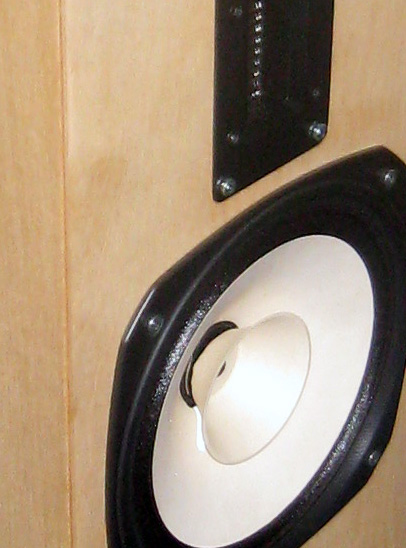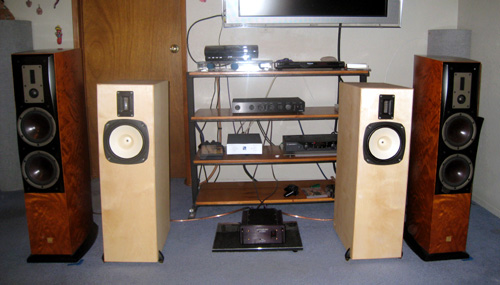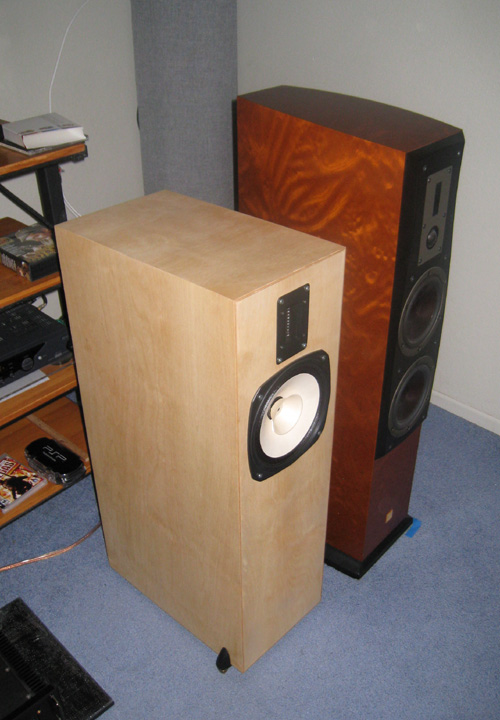
You are reading the older HTML site
Positive Feedback ISSUE
march/april 2008
tonian labs
TL-D1 loudspeakers
as reviewed by Francisco Duran

|
There is a popular TV program running on cable that deals with, of all things, busting myths. Things like, "would you survive if you jumped from a building and let the window awnings break the fall?" Or how about the show that had something to do with how fast bullets travel through water. There has been some myth busting going on at my home as well. But instead of death defying feats from buildings or any kind of bullet speed, it had to do with loudspeakers. The myths here seemed to be long standing in the world of high end audio. Take for instance this dinosaur, a speaker with a solid, and heavy cabinet will damp vibrations better and therefore sound better than a speaker with a thin and somewhat flexible cabinet. How about this one, speaker drivers made of exotic and composite materials perform better and sound much faster than plain paper drivers. And finally, does a more expensive speaker outperform one that is less expensive?
It all started with a call to Tonian Labs. One of the first questions owner Tony Meniasan asked me was why I was interested in his speakers. Two of my main reasons had to do with sensitivity and weight. I have never been a fan of insensitive speakers. More to the point is the type of amps it takes to run these speakers sound very unmusical to me. I have always been fond of simpler, low powered amps. Secondly, there are times when I need to move my speakers. They are heavy and ideally they take two guys to move them. My son usually gets stuck with the chore of helping the old man. I long for a speaker that is lighter than my big Dalis but perform on an equal level musically. I was initially interested in the Tonian Labs speakers with the PHY drivers. But those were not available at the time. So Tony graciously agreed to drop off (we live close) a pair of his TL-D1 for me to listen to. The model TL-D1 is a 2-way semi-open baffle design with a bass/midrange unit of an 8" Fostex driver. The tweeter is a ribbon unit which Tony modifies. The frequency response is 42-40kHz, with a nominal impedance of eight ohms, sensitivity is at 95dB. Their dimensions are 17 x 10 x 33 inches with a Baltic birch plywood enclosure and a shellac finish. The cost is $1750 per pair. The back of the speaker sports a plywood rectangular plate to adjust the bass port to your room. Neat. Four brass and plastic spikes are provided for each speaker and two binding posts are mounted mid way around back.
As I met Tony in my driveway, I noticed he had the TL-D1 stacked up in the back seat of his car lying on their sides. There went the finish I thought. But I needn't worry. This particular pair had unfinished cabinets. As soon as we got the speakers in the house and set up is where the audiophile myths started to creep into my mind. On looks and size alone my Dali Euphonia speakers had it all over these little floor standing speakers. This was even after taking into account that the Tonian TL-D1 were naked in their unfinished appearance. There was at least one similarity though. The Dalis also have a ribbon tweeter. They have two 6-inch composite wood bass drivers as well. The cabinets are solid—baby—solid with the ribbed granular technology and thick multi dimensional MDF cabinet. These 70 pounds sculpted beasties also require four substantial spikes per speaker mated to a solid plinth to "anchor” them down to the floor.
The Tonian Labs TL-D1 on the other hand are rectangular, shorter, and are built of birch plywood a lot thinner than the usual thick-as-a-brick construction of most other speakers. The idea of the thinner wall plywood is for resonance control more like a musical instrument as opposed to the more traditional speaker building approach of resonance damping as in the use of MDF, carbon fiber, or metal enclosures. After a closer look at the TL-D1's, there is some very fine cabinet work to these speakers. The inside too has been paid special attention, it is lined with natural wool fiber.

At first my Dalis were moved off to the side of the room and the Tonian speakers were left to do their thing. But they needed at least one hundred hours of break in. The thing is I could only keep them for one week. So there was no time for foot dragging, work was at hand. To say the least I was very impressed with these speakers right out of the box, that is, right out of the car. Break in time was not done with much "serious” listening. I did the usual TV watching and occasional CD in the background to break them in. That left only a few days to get their mettle.
When Tony and I first set up the speakers, I tried to pick some CDs that I thought would have a wide array of music to showcase what the TL-D1 could do. That idea was quickly blown out the window. Tony also brought along a CD of his own creation. Although it was basically what you would call a test CD. It was a recording of a guy playing drums. It was the most phenomenal recording I have ever heard of any kind of music period! As we set up the speakers and ran through some CD's Tony and I had a very interesting audio conversation. He mentioned to me that he has designed an acoustical lens that works with microphones when recording. By the sound of his recording, his acoustical lens seems to be a technological wonder. It was also interesting to hear Tony's views on high end audio, they seem to be grounded in a practical application of engineering and common sense.

After listening to a few of my cherry picked CDs, I cut Tony loose on my CD collection. His two picks were the Living Stereo of Bartok with Reiner and the Chicago Symphony and Mighty Sam McClain's Give it up to Love on JVC XRCD. These are two excellent recordings and the music ain't half bad either. I mentioned to Tony before he came over that my passive's volume control was on the blink. So he also brought an older Audiolab 8000a-integrated amp to use. The idea was to bypass the internal amp and use its volume control with my separate amps. We used it both as an integrated amp and also with its volume control into my amps. The Audiolab amp could be the subject of a myth busting all its own. Even its phono section was very good. But for now lets just say that it performed quite above and beyond its call of duty. And yes I did use its tone controls from time to time.
I will skip to the last few days of listening instead of giving you a blow by blow description of the break in process. Initially I was told that over the few days of break in the speakers would adjust to the humidity of the room and the sound would change accordingly. They did. They changed from a little cool and very slightly mechanical sound (something most unbroken in speakers sound like) to a more warm, open and spacious sound. This change was before the one hundred-hour break in. I guess you could say that they dialed themselves in.
It has been argued by some in the audio community that in order to reproduce music correctly, the speed in the music's dynamics and transients must come through the speakers intact. That is something easier said than done. Fortunately that is the great strength of the Tonian Labs TL-D1 speakers. Music is reproduced with a natural life like speed that aids in the reproduction of transients and dynamic contrasts sound incredibly clean and fast. The separations of the notes and dynamic clarity all blend to give the music a high degree of accuracy. I must emphasis though while these speakers sound fast and clean and dimensional, they did not sound thin, etched or bright in any way. Bass drums, horns, or guitars had the natural speed of instruments one hears when they are being played right in front of you live. Both drivers blend seamlessly to give an even tonal balance yet with a truthful separation of notes transient attack and quickness that rendered music in a most natural manner.
To give a musical example, I once again turned to Brazil for help. The disk I chose is called Tribalistas. The core group is made up of Arnaldo Antunes, Carlinhos Brown and Marisa Monte. I have listened to this CD many times. During the TL-D1's audition, I picked up the DVD version of this CD at my favorite music store, Amoeba Records. I used both disks for the audition. Pressing the subtitle button on the remote gave me new insight into the Portugese language. Watching the videos showed me that these very talented musicians use just about everything in the studio and then some to make music. A bell swinging from a string, percussion instruments that were made from crude wooden boxes and in one instance, a portable car vacuum. Along with the standard repertoire of guitar, drums, piano, and accordion, the musicians blended all the instruments together to make some beautiful music. Through the TL-D1, this music was reproduced in the most life like manner I have ever heard. The subtitles of percussion, the slight vocal inflections, even the soft brushes of a thumb to a hand-held drum were all there in front of me. Bass and drums sounded quick, clean and full. Vocals sounded real.
Larger scale music from artists such as Bartok, Respighi or even Hovanness sounded great through the TL-D1. Although the scale in which this music was reproduced wasn't as grand as with a much larger speaker, the TL-D1 didn't slow down the rhythm and timing of large scale orchestral works one bit. In fact the performance of these speakers with this music enhanced my listening pleasure due to its speed and accuracy. Since the TL-D1 are so fast, I asked Tony if some of his customers use sub-woofers with his speakers. He said that they blend well with subs.
On the last day of the session, the day before Tony came to pick up his speakers, I put the big Dali's back in the listening room. I set the Dali's up on the outside of the Tonian pair, with their supplied jumpers and used only one pair of Analysis Plus speaker cable. I used the cable with the Z plug bananas for ease of switching. As soon as I switched to the Dali's the differences between these two speakers hit me hard. Now let me tell you this, the Dali Euphonia MS-4 are nice speakers. I like them. But just as with everything in life something better always seems to come along. The Dalis sounded slightly thinner in the midrange, wispy in the top end, significantly slower in dynamic and transient reproduction, and almost syrupy in comparison. Surprisingly in the bass there was not that much difference considering the extra set of six inch drivers on the Dali's. Here was a speaker worth nine grand that was getting trounced by a pair of speakers that cost a few hundred less than two thousand dollars. Not only that, the less expensive speakers didn't even have heavy cabinets or exotic drivers. I was flabbergasted and slightly heart broken and a little bit in disbelief. Did I mention that the Tonian Labs speakers were a whole lot cheaper than the Dali's?

I can break it down in audiophile terms like I did above. I can also say that above all else that the Tonian Labs TL-D1 loudspeakers were musical as all get out, accurate and very engaging to listen to, very engaging. Am I gushing? Yes but in my defense I will say that I have not gone crazy, lost my hearing, or definitely have not been under the influence of any chemicals unless you count my blood pressure medicine. I have just happened to run into a very musical speaker. The differences between these two pair of speakers were easily heard. The differences lingered well after the Tonian speakers were gone I might add. In fact I am in the process of selling my Dali's in order to buy a pair of Tonian Labs Speakers. That is how much I liked them. All this with the Fostex drivers. I can imagine what the more exotic drivers in the Tonian Labs arsenal sound like. Well to say the least it looks like some audio myths have definitely been busted here! Well done Tonian Labs! Francisco Duran
TL-Di loudspeakers
Retail: $1750 a pair
Tonian Labs
web address:
http://www.tonianlabs.com
